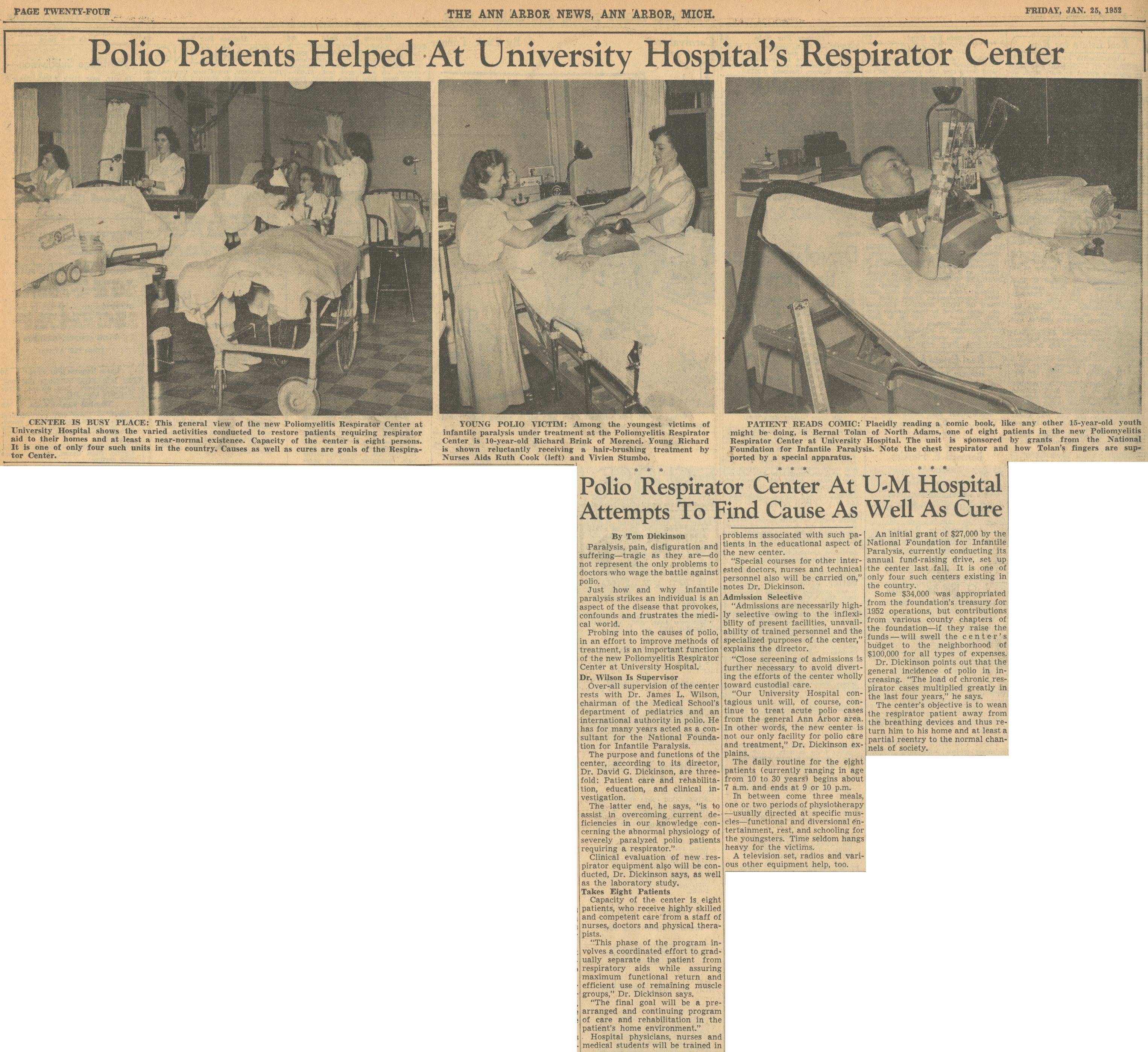Polio Patients Helped At University Hospital's Respirator Center

Polio Patients Helped At University Hospital's Respirator Center
Friday January 25, 1952
Polio Respirator Center At U-M Hospital Attempts To Find Cause As Well As Cure
By Tom Dickinson
Paralysis, pain, disfiguration, and suffering - tragic as they are - do not represent the only problems to doctors who wage the battle against polio.
Just how and why infantile paralysis strikes an individual is an aspect of the disease that provokes, confounds, and frustrates the medical world.
Probing into the causes of polio, in an effort to improve methods of treatment, is an important function of the new Poliomyelitis Respirator Center at University Hospital.
Dr. Wilson Is Supervisor
Overall supervision of the center rests with Dr. James L. Wilson, chairman of the Medical School's department of pediatrics and an international authority in polio. He has for many years acted as a consultant for the National Foundation for Infantile Paralysis.
The purpose and functions of the center, according to its director, Dr. David G. Dickinson, are threefold: Patient care and rehabilitation, education, and clinical investigation.
The latter end, he says, "is to assist in overcoming current deficiencies in our knowledge concerning abnormal physiology of severely paralyzed polio patients requiring a respirator."
Clinical evaluation of new respirator equipment also will be conducted, Dr. Dickinson says, as well as the laboratory study.
Takes Eight Patients
Capacity of the center is eight patients, who receive highly skilled and competent care from a staff of nurses, doctors, and physical therapists.
"This phase of the program involves a coordinated effort to gradually separate the patient from respiratory aids while assuring maximal functional return and efficient use of remaining muscle groups," Dr. Dickinson says.
"The final goal will be a prearranged and continuing program of care and rehabilitation in the patient's home environment".
Hospital physicians, nurses, and medical students will be trained in problems associated with such patients in the educational aspect of the new center.
"Special courses for other interested doctors, nurses, and technical personnel will be carried on," notes Dr. Dickinson.
Admission Selective
Admissions are necessarily highly selective owing to the inflexibility of present facilities, unavailability of trained personnel, and the specialized purposes of the center," explains the director.
"Close screening of admission is further necessary to avoid diverting the efforts of the center wholly toward custodial care."
"Our University Hospital contagious unit will, of course, continue to treat acute polio cases from the general Ann Arbor area. In other words, the new center is not our only facility for polio care and treatment," Dr. Dickinson explains.
The daily routine for eight patients (currently ranging in age from 10 to 30 years) begins about 7 am and ends about 9 or 10 pm.
In between comes three meals, one or two periods of physiotherapy - usually directed at specific muscles - functional and diversional entertainment, rest, and schooling for the youngsters. Time seldom hangs heavy for the victims.
A television set, radios, and various other equipment help, too.
An initial grant of $27,000 by the National Foundation for Infantile Paralysis, currently conducting its annual fundraising drive, set up the center last fall. It is one of only such four centers existing in the country.
Some $34,000 was appropriated from the foundation's treasury for 1952 operations, but contributions from various county chapters of the foundation - if they raise the funds - will swell the center's budget to the neighborhood of $100,000 for all types of expenses.
Dr. Dickinson points out that the general incidence of polio is increasing. "The load of chronic respirator cases multiplied greatly in the last four years," he says.
The center's objective is to wean the respirator patient away from the breathing devices and thus return him to his home and at least a partial reentry to the normal channels of society.
Images
Center Is Busy Place:
This general view of the new Poliomyelitis Respirator Center at University Hospital shows the varied activities conducted to restore patients requiring respiratory aid to their homes and at least a near normal existence. Capacity of the center is eight persons. It is one of only four such units in the country. Causes as well as cures are goals of the Respirator Center.
Young Polio Victim:
Among the youngest victims of infantile paralysis under treatment at the Poliomyelitis Respirator Center is 10-year-old Richard Brink of Morenci. Young Richard is shown reluctantly receiving a hair-brushing treatment by Nurses Aids Ruth Cook (left) and Vivian Stumbo.
Patient Reads Comic:
Placidly reading a comic book, like any other 15-year-old youth might be doing, is Bernal Tolan of North Adams, one of eight patients in the new Poliomyelitis Respirator Center at University Hospital. The unit is sponsored by grants from the National Foundation for Infantile Paralysis. Note the chest respirator and how Tolan's fingers are supported by a special appartus.
Article
Subjects
Tom Dickinson
National Foundation for Infantile Paralysis
Physical Therapy
Polio
University Hospital
University of Michigan - Faculty & Staff
University of Michigan Medical School
Has Photo
Old News
Ann Arbor News
Richard Brink
Ruth Cook
Vivien Stumbo
Bernal Tolan
James L. Wilson
David G. Dickinson
Tom Dickinson